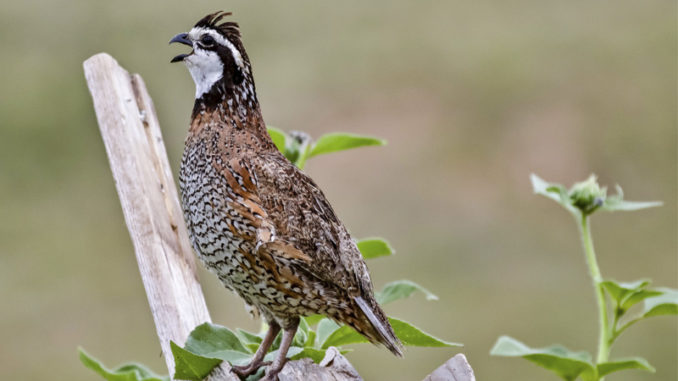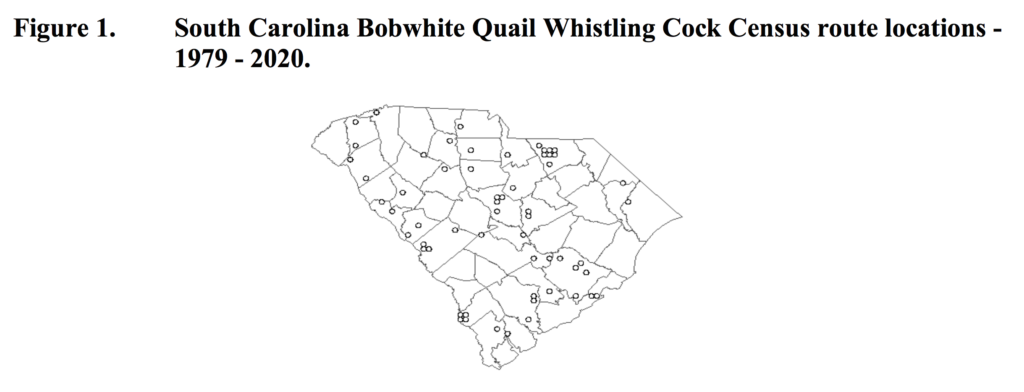
2020 Bobwhite Quail Whistling Cock Census shows promising results
The Bobwhite Quail Whistling Cock Census was conducted for the 42nd consecutive year in 2020. Sixty-six routes were sampled in 2020, resulting in 63 routes which yielded data comparable to the previous year.
This year, a majority of SCDNR’s partnering cooperators were unable to run the established routes due to work restrictions stemming from COVID-19. The approximate locations of survey routes are shown in Figure 1.
 Methods
Methods
Census routes are sampled between June 15 and July 10. Wildlife biologists believe this is the period of maximum bobwhite whistling in the Southeast (Rosene 1969). Each route consists of 12 stops at 1/2-mile intervals. Exactly eight minutes are allotted for listening at each stop, beginning at official sunrise.
The number of calling males is recorded at each stop and totaled for the entire route. Route totals are used for trend comparisons. Weather conditions are also recorded, and operation of routes is discouraged on rainy or windy days.
Based on an extensive analysis of historical Whistling Cock Census data, the survey protocol was changed in 2003 from a two-day survey to a one-day survey. The afternoon listening period was also eliminated as an option in the survey protocol.
As in previous years, data were analyzed using a paired t-test for equal sample sizes (Steel and Torrie, 1980). Between-year comparisons were conducted using all routes that were run in both 2019 and 2020. The 2020 mean was also compared with the long-term average using a paired t-test.
Results and discussion
Approximately 53 observers surveyed 66 routes in 2020. Sixty-three of these routes were used in year-to-year comparisons. A total of 403 whistling cocks were recorded on the 65 routes for an average of 6.4 (SE = 0.94) birds per route. For all routes sampled, a total of 406 whistling cocks were recorded with an average number of calling birds of 6.2 (SE = 0.90) birds per route.
The 2020 mean call count index did not significantly differ (P>0.05) from the 2019 index. The 2020 index was significantly less than (P<0.01) the long-term average for the 42 years of the census (16.2 birds/route, N=2081).
Quail counts in 2020 were higher on 27 routes (42%) and lower on 19 routes (30%) compared to 2019. Statewide, 41 more birds were recorded in 2020 than on the same routes in 2019, an increase in 11.3%.
Because of natural mortality, breeding populations of quail are never high relative to early fall populations. Extreme weather conditions during the nesting season and land-use changes can further depress quail numbers.
Whistling Cock Survey data are used in conjunction with Quail Brood Survey data, Quail Hunter Survey data, and Fall Covey Count data to assess the population status of quail statewide as well as the effects of land use change and other factors such as weather on the statewide quail population.
Land-use changes surrounding routes is the most difficult variable to quality. When routes for the Whistling Cock Census were established in 1979, cooperators were instructed to locate census lines in areas where good quail populations existed. Routes are not moved to new locations unless access is limited or noise disturbance makes counting calling birds impossible.
Many routes which were established through mixed forest and farmlands are now surrounded by pine plantations. Therefore, a dramatic decrease in the suitability of the habitat surround survey routes is thought to have severely depressed the numbers of calling birds on many routes. While large-scale habitat changes are obvious and are easily documented, it is much more difficult to quantify habitat changes at the call count route or point level. Analysis of fine-scale habitat components along survey routes should be conducted to validate the effects of habitat change on local quail populations.
It is important to note that the full complement of routes were established to document year-to-year and long-term population changes. Thus, populations are expected to decrease for a period of time and should rebound if the habitat reverts to a more suitable type.
The Bobwhite Quail Whistling Cock Census should be continued in order to monitor changes in habitat conditions and the resultant quail population response. Additional routes are needed in areas of low route density to increase the precision of the survey and to provide more complete statewide coverage.

 Methods
Methods
Be the first to comment